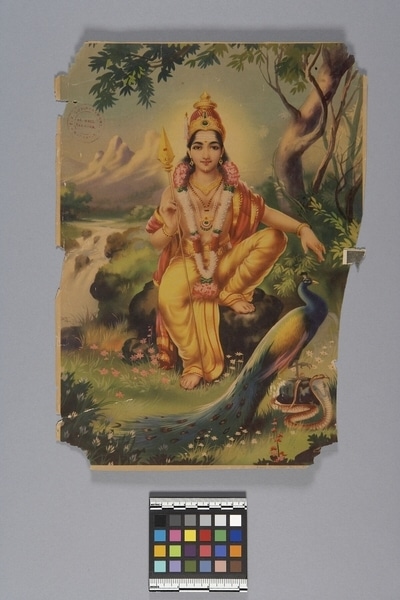Calendar Item Number: Eg164 from the MOA: University of British Columbia

Description
Rectangular shaped calendar print depicting Murugan seated on dark brown rock in lush green landscape of flowers and grass. He is positioned with his foot on right placed on rock, other on ground. Gold, long-shafted lance held upright in hand on left. He is wearing a yellow dhoti and a red wrap off shoulders. He is adorned with a pink, white and green floral garland, a gold jeweled crown and gold, pearl and bead necklaces. Three horizontal white lines and red dot on decorate his forehead. On the left is a waterfall and mountains; on right, a tree. There is a blue, yellow and green peacock standing near a snake along the bottom edge.
History Of Use
Indian popular religious prints have been published for nearly a century, first by German presses, later by Indian ones. The prints may take the form of calendars, posters, or simply images. The style of the representations is European. In the beginning they were Hindu images, but are now acquiring elements both of folk art and a romantic secularism. It is a living art currently influenced by the movie industry and non-Hindu religions. The images are a vehicle for advertising and are also used for religious purposes.
Iconographic Meaning
Murugan, great integrator among divinities and perfect son of Shiva and Parvati, is the divine child and source of power, love, and wisdom. He is the warrior god who defeats Taraka, the evil demon/giant, with his lance, 'Sakti-vel'. Also identified by: appearing together with Parvati, Ganesh, and/or Shiva; three white lines and third eye or ascetic symbol stating association with Shiva; attendant peacock, feathers of which have many eyes radiant of the sun; brahminical thread across chest; moon, toy; red and gold in association with the earth and sun; and the rooster.
Cultural Context
calendar art; popular religious art
Item History
- Made by C. Kondiahraju (Maker) in India during 1940
- Collected between 1974 and 1982
- Owned by Stephen Inglis before January 1983
- Received from Stephen Inglis (Donor) during January 1983
What
- Name
- Calendar
- Identification Number
- Eg164
- Type of Item
- calendar
- Overall
- height 36.2 cm, width 26.3 cm
Who
- Culture
- South India
- Creator
- C. Kondiahraju (Maker)
- Previous Owner
- Stephen Inglis
- Received from
- Stephen Inglis (Donor)
Where
- Holding Institution
- MOA: University of British Columbia
- Made in
- India
When
- Creation Date
- during 1940
- Collection Date
- between 1974 and 1982
- Ownership Date
- before January 1983
- Acquisition Date
- during January 1983
Other
- Item Classes
- works on paper
- Condition
- poor
- Accession Number
- 0857/0018